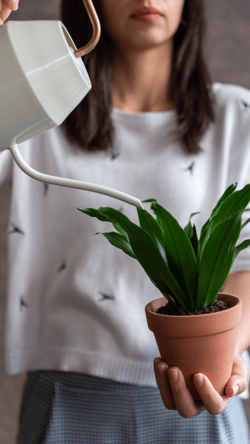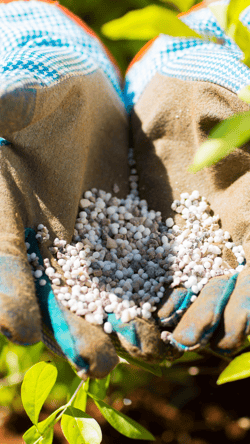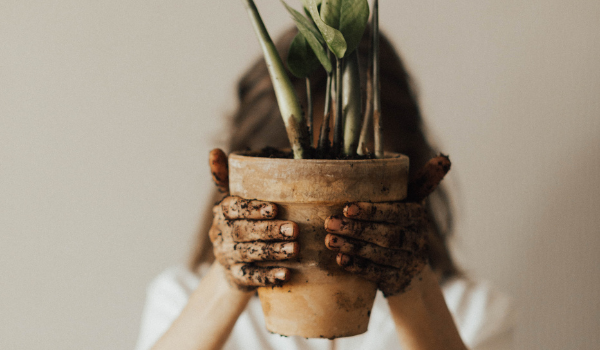There are several specialty mixes that generally reveal themselves (e.g. Orchid mix, Seed & Cutting mix, Succulent & Cacti mix), however when you’re just looking for a good quality, all-round potting mix, it can be hard to work out why one bag is cheap while another bag is more expensive; and what the difference is when it comes to your plants.
If you’re looking to repot a root-bound plant into a larger pot, or a plant is just in need of repotting, the potting mix you choose will determine the future health and success of your plants. Look for a suitable mix depending on the type of plants you have. Some plants appreciate a nutrient-rich, light and airy mix, while others will respond better to a mix with good water retention. The majority of plants will respond best to a balance of aeration, water retention and adequate nutrients.
Because planting into containers and pots is different and more confined than planting directly into the ground; potting mix has been specifically designed for this situation.
There are 3 key characteristics to consider when selecting a suitable potting mix for your plants:
- Air-filled porosity
- Water holding capacity
- Availability of nutrients
Air-filled porosity
 Plants need air (and not just the parts above the ground!). The presence of tiny air pockets throughout the root zone is so important to the health of plants, how they take in essential nutrients and for the soil food web we are trying to encourage (bacteria and decomposers like worms and fungi). Without these pockets of air most plants will survive, but not thrive. A potting mix with a high air-filled porosity like Rocky Point’s Coco Pro, is well drained, however may require more regular watering in the warmer climates; therefore a potting mix with a high air-filled porosity will generally have a lower water holding capacity. Coco Pro however, has the added benefit of coir chips, which act like little sponges to hold in more of the moisture that your plants need.
Plants need air (and not just the parts above the ground!). The presence of tiny air pockets throughout the root zone is so important to the health of plants, how they take in essential nutrients and for the soil food web we are trying to encourage (bacteria and decomposers like worms and fungi). Without these pockets of air most plants will survive, but not thrive. A potting mix with a high air-filled porosity like Rocky Point’s Coco Pro, is well drained, however may require more regular watering in the warmer climates; therefore a potting mix with a high air-filled porosity will generally have a lower water holding capacity. Coco Pro however, has the added benefit of coir chips, which act like little sponges to hold in more of the moisture that your plants need.
Some key ingredients in potting mix that promote good air-filled porosity include:
- Composted bark
- Coir chip/fibre
- Clinker/charcoal
- Zeolite
- Perlite
- Sand
Water holding capacity
 Plants need water (who would have thought!). Depending on the potting mix, and what ingredients have been used, the ability of the potting medium to retain and hold water in the root zone will be different. While we still aim to have a free draining mix, some mixes will “hang on” to water and moisture longer, making it available to plants for a longer period of time. Some plants that like to be wetter than others appreciate a mix with good water holding capacity like Eco Potting Mix or Grow More Premium Potting Mix, while others will prefer the better draining characteristics and air-filled spaces created in a professional or premium grade mix like Rocky Point’s Premium Potting Mix. Potting mixes with a high water holding capacity generally require less frequent water than others (great if you wish to conserve every drop). The addition of compost helps to increase the water holding capacity of potting mix, but also assists with greater availability and uptake of essential nutrients.
Plants need water (who would have thought!). Depending on the potting mix, and what ingredients have been used, the ability of the potting medium to retain and hold water in the root zone will be different. While we still aim to have a free draining mix, some mixes will “hang on” to water and moisture longer, making it available to plants for a longer period of time. Some plants that like to be wetter than others appreciate a mix with good water holding capacity like Eco Potting Mix or Grow More Premium Potting Mix, while others will prefer the better draining characteristics and air-filled spaces created in a professional or premium grade mix like Rocky Point’s Premium Potting Mix. Potting mixes with a high water holding capacity generally require less frequent water than others (great if you wish to conserve every drop). The addition of compost helps to increase the water holding capacity of potting mix, but also assists with greater availability and uptake of essential nutrients.
Some key ingredients in potting mix that promote good water holding capacity include:
- Compost
- Coir chip/coir peat
- Sawdust
- Natural and artificial wetting agents
Availability of nutrients
 Most, if not all types of potting mix contain nutrients plants need to grow. Whether they are organic nutrients from organic matter (like compost), or added synthetic fertilisers that are in a plant-ready form, they will feed your plants. The amount of nutrient present, and the type of synthetic fertiliser added will determine how much food your plant will have access to (and how long it will last). The less expensive potting mediums generally have only a limited amount of plant available nutrients, so will need to be supplemented with other fertiliser sooner than some of the more expensive products (which can often have enough fertiliser to feed plants for over 14 months).
Most, if not all types of potting mix contain nutrients plants need to grow. Whether they are organic nutrients from organic matter (like compost), or added synthetic fertilisers that are in a plant-ready form, they will feed your plants. The amount of nutrient present, and the type of synthetic fertiliser added will determine how much food your plant will have access to (and how long it will last). The less expensive potting mediums generally have only a limited amount of plant available nutrients, so will need to be supplemented with other fertiliser sooner than some of the more expensive products (which can often have enough fertiliser to feed plants for over 14 months).
Some common nutrients, fertilisers and soil conditioners to look out for include:
- Controlled release fertiliser (N,P,K)
- Trace elements (micronutrients)
- Compost
- Gypsum, lime
- Fish and/or seaweed extract
When it comes to potting mix, most plants enjoy a balance between good air-filled porosity and good water holding capacity. Most professional and premium grade potting mediums do offer this, and also come with enough fertiliser to keep your plants going over a certain amount of time (thanks to the controlled release fertilisers). While the potting mediums with a large proportion of compost will generally have a lower air-filled porosity and less plant ready nutrients, this can be overcome with the addition of your own fertiliser and ingredients to improve drainage (and get some air into the root zone).
So, next time you’re picking up a few bags of potting mix for a fun weekend in the garden, just remember to give your plants what they need.
_MEB.png?width=842&height=596&name=RP_HorizontalColour(R)_MEB.png)



